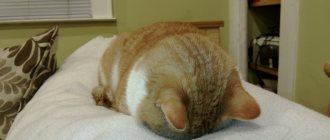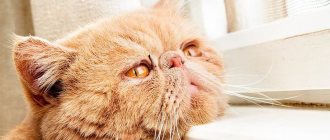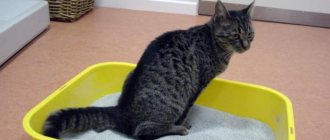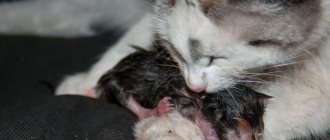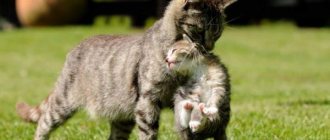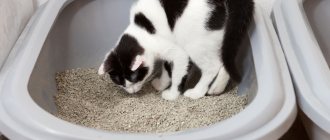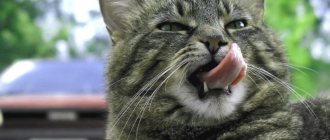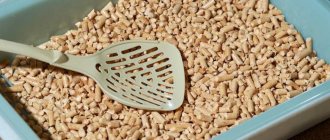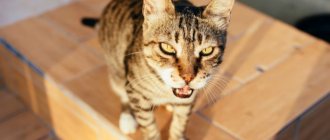Cats, like people, experience constipation, and it happens quite often. This causes a lot of inconvenience for the cat, and unnecessary worries for the owner, because he wants to help his pet, but often does not know how. Some owners expect the problem to resolve itself, but you shouldn’t hope for a miracle. The animal needs help, but it cannot solve its problem on its own. The article will examine in detail the question: why the cat does not go to the toilet, and whether it is possible to somehow help her with this.
Why don't kittens go to the toilet?
When a small kitten appears in the house, the whole family does not leave its side. Some want to play, some are simply touched, and some are monitoring his condition. And quite often it happens that a small kitten stops going to the toilet, and this problem should be solved. But before looking for a solution to the problem, you should find out the reasons for its occurrence.
- A small cat does not go to the toilet due to the stress she received while moving to a new home. This is a kitten's natural reaction to a change in environment. When kittens arrive at their new home, they may go for about three days without going to the litter box at all, and this is considered normal behavior. But this process should be controlled, because if after five days the tray is still empty, this means that the baby needs help.
- A similar problem may occur in kittens who still live with their mother, but due to her inexperience or for another reason, she may not help the kittens defecate, although in the first month of their life, responsibility for this process lies entirely with the mother cat. She should give them a special massage on their stomach to make it easier for them to go to the toilet.
- If a kitten is switched to natural food too early, the digestive system may not be able to cope with this difference. It’s good when, while still receiving mother’s milk, the kitten is already familiar with regular food. Then the process of transition from milk to natural food is absolutely painless.
- There is such a thing as congenital intestinal pathology. In this case, the kitten will not be able to go to the toilet normally without the help of a veterinarian.
The cat is yelling and can’t go to the toilet, what should I do?
Please note that the owner’s task is to alleviate the pet’s plight and help him go to the toilet. There are several ways to provoke urination.
The cat is yelling and can’t go to the toilet, what to do, how to understand that the cat needs help:
- He often stomps around in the litter box, spends a lot of time there, screams, but cannot go to the toilet.
- Feels unwell, there is apathy, worsening mood.
- The pet can break away from the owner’s hands and refuse the caresses that until recently he loved very much.
- The cat's temperature rises, or, conversely, decreases.
- The cat may refuse to eat or drink. Or, conversely, dryness occurs due to temperature.
- If the cat managed to pee, then there is a very small amount of urine, there is mucus, blood, and lumps in it.
Filler
Causes of illness in adults
The reasons why a cat does not go to the toilet in a big way are different from those that were suitable for a kitten.
- Poor nutrition. If you feed your animal food that contains a minimum of fiber and protein, this can cause severe stool problems. The same symptoms appear in cats that eat too many bones or drink little fluid.
- Quite often, the problem of lack of stool occurs in long-haired cats, because there is too much hair in their stomachs, which gets there at those moments when the cat “washes itself.” Hairs that enter the stomach become clumps, which, in turn, become a serious obstacle not only to the release of feces, but also to their formation.
- Stressful situations have a negative impact not only on children, but also on adults. Cats and cats may be frightened as a result of meeting a dog, and perhaps they will be frightened by a too noisy company that will be visiting. One of the breeders in his review says that after moving, his cat did not go to the toilet for a whole week, but the veterinarian did not find any disturbances in the functioning of the body.
- When a cat is already in old age, the functioning of the gastrointestinal tract can greatly deteriorate, since the intestines are no longer able to work with the same activity as they did at a young age. This is why feces do not pass through their channels well.
- Everyone knows that a neutered cat is a very lazy cat that spends its energy only on eating. And the rest of the time he just lies there. Therefore, they are prone to obesity, which often leads to the fact that the process of defecation is difficult, and the cat cannot go to the toilet without outside help.
- If after sterilization the cat does not go to the toilet for more than four days, then this is a reason to consult a doctor. Because this is how reflex constipation manifests itself, which is a consequence of such an operation.
- And the last point will be various diseases that have similar consequences or symptoms.
Why can't the cat go to bed?
Oddly enough, this is a fairly common problem, especially among those breeders who save on the health of their pets. The thing is that economy-class food contains a large number of products, as well as food additives that contribute to the accumulation of salts. Thus, the environment of urine changes, and conditions are created that are favorable for the formation of stones. This is why pets who regularly eat cheap food often develop stones in the kidneys and bladder, which causes pain and difficulty defecating.
Why can't the cat go to bed:
- Congenital diseases . There are breeds that are predisposed to such diseases. They most often develop chronic diseases of the kidneys and urinary tract.
- Eating economy class food.
- Violation of containment conditions. The fact is that cats are afraid of drafts, as well as uncomfortable, uncomfortable places to rest that are not covered with fabric or a pillow.
- Consequences of sterilization. This is why it is necessary to sterilize cats at a certain age, since violation of age norms leads to the fact that they may develop problems with the urinary tract.
- Traumatization. Most often, males face urinary problems due to their aggressive nature. Cats are prone to injury and can fight, especially if they are outdoors.
- Stressful situations. Very often, communicating with dogs, traveling to exhibitions or traveling in a pet basket becomes real stress.
- Large body weight. Often occurs in males who have been castrated. Overeating contributes to obesity and the occurrence of additional pathologies, including the kidneys and urethra.
- Old age. Cats may indeed experience difficulty defecating due to old age.
cat
Help an animal
Undoubtedly, if you notice that your cat does not go to the toilet for several days, then this is a serious reason to seek help from a veterinarian. But if this is not possible, then you can try to help the animal yourself in order to alleviate its suffering at least a little.
- The first step is to review your pet's diet. The menu must include milk and vegetables. If there is such an opportunity, then kefir.
- Vaseline oil has a very good softening effect. Veterinarians recommend adding it to the food of even healthy cats as a preventive measure. It is absolutely harmless to the animal. Five drops once a day will be enough for your cat to have problems with stool much less frequently. Some people replace Vaseline oil with vegetable oil, but this should not be done, since the latter has a very bad effect on the animal’s liver.
- If the problem has arisen for a long time, then you can try giving your pet a laxative. Duphalac and Lactusan are well suited for this. If you study the reviews of breeders, these drugs are the best for constipation in cats.
- Some veterinarians recommend giving cats enemas, which can alleviate the animal's condition. But there are several caveats here: firstly, an enema cannot be done at home, and secondly, you should not resort to this method too often, since this weakens the intestinal muscles, and there is a serious risk of chronic constipation.
- You can use the advice of experienced breeders who talk about the effectiveness of condensed milk. It is diluted with ordinary running water in a ratio of three to three. Every hour the pet should drink a tablespoon of this liquid. But don’t get too carried away, and five doses a day will be enough. This liquid will relax the stomach and return the cat to the ability to defecate normally.
- If the problem arises in a small kitten, then you can try giving him a massage, which will also relax the muscles and help the baby do his job. You should take a cotton pad, previously soaked in warm water, and move it clockwise over the baby’s tummy.
- Perhaps your cat should normalize its intestinal microflora. In this case, special medications that can be prescribed by a veterinarian will help.
Treatment of defecation retention
Treatment of constipation in cats consists of finding out the root cause of this dangerous phenomenon, and then you can think about how and how to help your pet.
If the suspicion falls on intestinal obstruction, then drinking and force-feeding will simply lead to such consequences as intestinal rupture and peritonitis. The doctor will make an accurate diagnosis after palpation, x-ray or ultrasound.
After visiting the veterinarian, the owner will have a detailed treatment plan in his hands, unless, of course, surgical intervention is required. Each case is individual.
Let's consider the types of assistance that owners themselves can provide to their cat if the case is not so critical.
global $ads_google; //data-ad-slot=”2475549904″ $ads_google = empty($ads_google) ? false : true; ?> if ($ads_google == false) {?>
$ads_google = true; ?> } ?>
Laxatives
Among the laxatives that are used for sphincter spasms in the intestines or during narrowing of the intestinal lumen, you can purchase a substance in ampoules - magnesium sulfate. For cats, you need to take a dosage of 3 to 10 g per day.
A drug called sodium sulfate acts as an irritant to the intestinal walls, increases osmosis and allows water to accumulate. The expected effect time is 7-14 hours. Recommended dosage is 2-5 g.
Buckthorn bark in the convenient medicine Ramnil can be used for cats in a dosage of 0.5 tablets per day.
If constipation has already taken a chronic form and there is intestinal atony, then the animal should be given Izafenin. This drug becomes an irritant to intestinal receptors and helps improve the bowel movement process. The product is a powder and for an adult cat it is required to give from 1 to 5 mg per day. You can give the drug once or twice a day.
Here is a list of laxatives for constipation:
- Lactusan;
- Duphalac;
- Prelax;
- Vetelact;
- Guttalax.
Finding these laxatives is easy:
Enema
An enema is not the most pleasant procedure for a cat, and if there is constipation, it is very painful. To administer an enema, you need an assistant to securely fix the limbs and head. To carry out the procedure, you need to find a place convenient for fixation, usually a table. Prepare several liters of water at room temperature; you can replace it with a decoction of chamomile or flaxseed. The basin is positioned so that all feces fall into the water.
Take a baby bulb and lubricate its tip with Vaseline, draw in water and carefully insert it into the rectal opening. The liquid is squeezed out slowly. Afterwards, the pear is removed and the stomach is gently massaged. The contaminated water will begin to come out.
The manipulation is repeated until the feces are completely released. After the enema, the cat is supported with rectal anti-inflammatory suppositories.
Enema has a number of contraindications. You can't do it if:
- the owner knows for sure that the intestines can be damaged;
- blood flows from the anus;
- have diseases of the cardiovascular system;
- there is helminthiasis;
- during
pregnancy .
Vegetable oil
A loyal, but rather weak remedy for the treatment of constipation in cats. In this case, preference is given to olive, hemp or flaxseed oil. You can add it to food, but the cat himself is not averse to licking the oil off his fingers. Several hours pass, and after the first attempts the animal already goes to the toilet.
You cannot use the oil method every day, as this will have a very negative effect on the cat’s liver.
Vaseline or castor oil
A good way would be to use Vaseline or castor oil. The advantage is that they are not absorbed by the intestines, but penetrate into lumps of feces, which has a softening effect. Accordingly, peristalsis improves.
Oils are poured with a simple syringe without a needle. For the first time, up to 15 ml is administered, and after 4 hours another 5 ml. It is allowed to use the product up to 5 times a day, 5 ml every 4 hours.
Massage
global $ads_google; //data-ad-slot=”2475549904″ $ads_google = empty($ads_google) ? false : true; ?> if ($ads_google == false) {?>
$ads_google = true; ?> } ?>
Suffering cats can receive a gentle massage consisting of light pressure strictly clockwise. After waiting 15 minutes, the massage continues again. Not the fastest way, if you suspect intestinal volvulus, you should not massage your pet’s stomach; here you need the help of a qualified specialist.
Changing your diet
The first thing you need to understand: no matter how suffering and hungry a cat with coprostasis may seem, you cannot force feed it. If the animal still begs for food, then you can offer broth, and either soak the dry food or replace it with canned wet food.
There is a line of medicinal foods, you will learn about them below. First you need to solve problems with fecal output, and then think about buying such food.
If mistakes have been made in a cat’s diet and you need to change its diet, you cannot do this right away. Changes should happen smoothly and gradually, over a couple of weeks. It will be necessary to add a new type of food to the previous one and monitor the food reaction.
The water is always fresh and clean!
If your cat is a breed with long hair, you should consider adding holistic foods to its diet - they will prevent the hair from accumulating inside in clumps and thereby causing any type of digestive upset.
Phytotherapy
You can buy senna (cassia) leaves in a regular pharmacy. You only need 4-5 g, which are filled with hot water, given the size of the cat, you shouldn’t take a lot of water, 25 ml is enough.
The steamed raw materials are placed in a water bath for half an hour and cooled. After filtering, you can start feeding your pet.
This approach will help if the cat still, although with difficulty, goes to the toilet on its own.
Other methods
There is a folk method for this problem, but its effect is not strong, rather moderate.
A teaspoon of condensed milk is diluted with water and given to the patient to drink. You usually don’t have to ask; the cats themselves willingly lap up this product. But this method will not work if the cat is suspected of having diabetes.
Diet for cats
If your cat often suffers from constipation, you should put her on a diet that will greatly facilitate this process. So, the cat should eat the following foods:
- If the animal eats dry food, then it should be soaked, and also periodically given soups and cereals.
- Cats rarely agree to voluntarily eat vegetables, but they must be added to their food at least in small quantities. Zucchini, pumpkin and beets are especially effective for constipation.
- You can’t do without fermented milk products.
- You should not include raw fish and liver in your menu too often.
If a cat suffers from constipation, then rice, chicken meat and broths based on it, as well as chicken eggs should be excluded from its diet. If your cat often has problems with bowel movements, you should consult a veterinarian who will help you choose special food for your animal.
Causes of constipation?
The list is quite impressive. The most common are improper feeding, hair accumulation, and the possibility of a foreign body. Constipation is also possible due to renal failure, perineal hernia, inflammatory processes in the rectum and anus, disease of the paranal glands, diseases of the large intestine (for example, megacolon - a sharp increase in the volume of the large intestine and a decrease in its motility (sometimes congenital)), orthopedic problems ( there are difficulties with taking the appropriate position), tumor formations, prostate cysts in cats, narrowing of the anus due to scars. Neurological reasons should not be underestimated.
The problem of constipation is more common in sedentary animals, in cats that eat natural food, as well as in older animals (due to deterioration of the liver, metabolic disorders, orthopedic problems, etc.) and is more common in cats than in cats .
Prevention
It’s good to know how to combat constipation, but it’s even better to take all preventive measures in time so that this problem does not arise at all. First, you should pay attention to what your pet eats. Many owners feed their cats from their own table, which is absolutely forbidden to do. If you buy high-quality dry food for your cat, he will not have problems with bowel movements. And if the owner chooses natural food, then when creating a diet, you should consult with more experienced breeders or a veterinarian. After all, the menu should definitely include vegetables and meat.
The article already mentioned that cats quite often swallow their fur and, because of this, then cannot go to the toilet normally. To prevent this, you should constantly brush, especially for long-haired breeds.
British cat can't go to the toilet, how can I help?
In order not to treat your cat and deal with constipation, it is necessary to prevent it. To do this, it is enough to follow the measures.
British cat cannot go to the toilet, how to help:
- Brush your animal during the shedding period.
- Buy special food that stimulates the removal of hair from the intestines.
- The animal's diet should be balanced and contain a large amount of fiber.
- Give your animal something to drink regularly. It is best if the drinking bowl is available during the day. Change the water constantly, it must be fresh.
- You definitely need to walk and play with your cat.
- Physical activity stimulates the process of defecation.
- Under no circumstances should you throw small objects around the house, as the animal may swallow them. See your doctor regularly for checkups and vaccinations.
Filler
Problems with urination
After the problems and ways to solve them regarding constipation have been considered, it is worth paying attention to the animal’s urination. After all, if a cat doesn’t go to the toilet very often, then this is also a cause for concern. It is quite easy to notice this, since the animal will definitely communicate this with its screams, moans and endless meows. But even if he manages to go to the toilet, very little urine will come out, and this is unlikely to alleviate the animal’s condition. It is worth paying attention to the cat’s belly, which becomes bloated; any touch to the belly causes pain. If you pay attention to the tray after urinating, you can find traces of blood or even pus there.
Why doesn't a cat go to the toilet in a small way:
- If the pet does not have constant access to water, then there may not be enough fluid in its body. And a small amount of urine leads to the formation of stones in the kidneys or bladder, which, like in humans, prevent the passage of urine.
- This problem can be inherited.
- Such a pathology can be congenital, since sometimes kittens are born with a diagnosis such as urinary tract obstruction. It is impossible to solve this problem on your own, and only surgery can help.
- Poor nutrition leads not only to constipation, but also to problems with urination. Especially if the cat eats a lot of raw fish and meat, as well as mineral and salty foods.
- A cat doesn't go to the toilet much if it has a few extra pounds. After all, such pets move very little, as a result they not only get constipation, but also the outflow of urine worsens.
The cat cannot go to pee and burps, what should I do?
Such symptoms are observed with constipation, poisoning and pyelonephritis. Only a veterinarian can make an accurate diagnosis.
The cat cannot go to pee and burps, what to do:
- If the cat does not go to the toilet for 2 days, it is necessary to urgently take him to the veterinary clinic. At the clinic, the cat will be provided with first aid. To empty the bladder, a catheter is inserted into the urethra to allow urine to flow out.
- This manipulation is usually performed under general anesthesia so as not to injure the walls of the animal’s bladder. The procedure is very painful and is not done often, but if the reason for the lack of urination is urolithiasis, and there is stone or sand in the area of the urethra and urethra, the doctor may install a temporary catheter for several days.
- In this case, a collar is put on the animal so that the pet does not accidentally pull out, damage the catheter, or make a wound in the area of the urethra. You must also follow all the doctor's recommendations. He may prescribe antibiotics, antispasmodics, as well as diuretics and stone-dissolving medications. It all depends on what caused the lack of urination.
Filler
A lot of interesting information about keeping cats can be found in our articles:
Is it possible to give cats human tablets, No-shpu, Valerian tablets? How to give a bitter pill to a cat without spitting it out?
What can you feed a 1-6 month old kitten without a cat and how many times a day: list of feeds, products and dishes, feeding regimen
Is it possible to leave a cat alone for a day, 5 days, a week, two weeks? How long can you keep a cat or kitten: reviews, veterinarians’ opinions
Why does a cat itch and lick itself, but there are no fleas? The cat is constantly itching: causes, methods of treatment
Of course, it is very difficult for the owner to determine the cause of difficulty urinating. Cysts, fibroids, fibroids often cause difficulty urinating in females. The only thing the owner can do in this case is to alleviate the animal’s condition, that is, provoke a trip to the toilet, and make an appointment with the veterinarian.
Owner's actions. Reviews
Of course, if any problems are detected in the pet, the owner must immediately take him to the veterinarian, but it is not always possible to do this immediately, so you need to be able to provide assistance to the animal on the spot. Regarding issues with urination, judging by the reviews, you should do the following:
- Insert a catheter designed specifically for urine drainage. This procedure is quite complicated and brings a lot of discomfort to the cat, so it is not recommended to carry it out on your own. There are cases when the catheter was placed under general anesthesia. Often the procedure cannot be carried out, since the urinary canals become swollen, and the animal may completely lose the ability to urinate on its own.
- You should review your pet’s diet and provide him with constant access to clean and fresh water.
Symptoms
Unfortunately, the symptoms of the disease are not always immediately noticeable. And precious time may be lost.
How to determine if a cat is constipated, and what to do in this case? Check the tray daily. If within two to three days the consequences of the body’s vital activity appear only in liquid form, sound the alarm and contact a veterinarian.
Another sign of problems with the gastrointestinal tract is a tight and hot tummy of the pet. He becomes sulky, the cat does not allow him to touch his stomach and screams in pain.
Frequent urge
In veterinary practice, cases of not only rare urination are considered, but also when the cat often goes to the toilet in small quantities. There are many reasons for this, and each of them deserves a separate article. In short, diseases such as cystitis, urolithiasis, and diabetes can contribute to this. In this case, the cat goes to the litter box often, but little urine is released, and in some diseases it contains blood. During the hot season, pets drink a lot of liquid and because of this they may go to the toilet frequently, but this is not a reason to panic.
Sometimes cats do this to mark their territory. This phenomenon is temporary and should not worry the owner.
General information about castration of cats
Castration is one of the most popular operations performed both in a veterinary clinic and at home (by a doctor).
Castration is carried out for both females and males, in order to physically eliminate the causes of hormonal imbalances and sexual activity of the pet. Note that there are several methods of sterilization, that is, the cat remains sexually active, but cannot have offspring. On most forums, the term “castration” is replaced by “sterilization” for a softer perception... according to society, the word “castrato” sounds rude. Castration involves the removal of a cat's testicles by cutting the spermatic cords. There are several methods and approaches to performing the operation, but the final goal is always the same - removal of the testes and the fastest possible rehabilitation.
Despite the fact that castration is considered a routine operation and takes (an experienced veterinarian) no more than 15 minutes, it is performed under full anesthesia. The administration of anesthesia is always accompanied by:
- Loss of control over thermoregulation - after surgery, the cat must be kept on a heating pad and covered, and provided with warm drinks.
- Increased stress on the heart - you need to monitor the condition of the mucous membranes and the general condition of the cat.
- Decreased muscle tone is fraught with weakness.
- Load on the liver and kidneys - with complications, signs of intoxication appear.
After recovery from anesthesia, the cat is prescribed antibiotics, vitamins or supporting complexes and always painkillers. Even if the doctor says that pain relief is not needed, it is necessary! In a small dose, but on an ongoing basis for at least 2 days. Antibiotics are used to prevent infection, which is a standard procedure after surgery of any complexity.
Note! Before surgery, most doctors working in large clinics insist on examining the functioning of the cardiovascular system, especially in older and purebred animals. The main complications that occur during castration are associated with disturbances in heart rhythm and breathing.
Considering the low complexity of the operation, most veterinary surgeons hone techniques that allow for the fastest possible rehabilitation for a cat. In addition, caring for the animal after surgery does not cause much trouble for the owner.
Treatment
If urinary tract disease is detected at an early stage, there is a high probability that the animal will be completely cured. But the main thing in this matter is not to try to make a diagnosis and prescribe treatment on your own. Because in this way you can harm the animal even more. Moreover, if you put off going to a specialist for a long time, there is a real risk that the disease will become chronic, and any treatment will become meaningless.
Treatment of the disease
How to treat pyelonephritis in cats? Firstly, the disease is dealt with by a veterinarian. There should be no folk remedies or self-treatment. You need to understand that this is not a disease that can be cured at home. However, you can alleviate the condition of a suffering pet like this:
- The cat should be warm and completely at rest.
- Antispasmodics help relieve pain well.
- A gentle diet is required.
That's all the owner can do. The rest is up to the specialist. The doctor prescribes antibiotics, sulfonamides, and diuretics. Often the animal is given drips with glucose and potassium chloride.
Folk remedies
Vaseline oil has become quite widespread among folk remedies. It must be given to the cat in the morning on an empty stomach. The dose is calculated according to the weight of the pet; one milliliter of Vaseline oil should be added per kilogram of the animal’s body weight. After taking the medicine, you must wait until the evening. If the cat still does not go to the toilet, give your pet another dose.
Some pet owners advise feeding their cat Vaseline oil every hour, while increasing the serving size. This opinion is based on the fact that when using petroleum jelly, the product is not absorbed into the intestines, due to which its undigested remains simply flow out of the anus. If the cat does not want to drink the oil, the required dose can be poured into the animal’s mouth from a syringe without a needle.
Another folk remedy is regular or condensed milk diluted with water. It is recommended to buy classic condensed milk, which consists, in addition to milk itself, only of cream and sugar.
